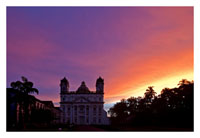 Your first stop is the Basilica of Bom Jesus. While noted for its size and style, the Bom Jesus is visited mainly for the precious relic it contains. Here worshipers, or the simply curious, may view the body of Saint Francis Xavier (d.1562), which lies partially exposed in a dazzling silver casket. Your first stop is the Basilica of Bom Jesus. While noted for its size and style, the Bom Jesus is visited mainly for the precious relic it contains. Here worshipers, or the simply curious, may view the body of Saint Francis Xavier (d.1562), which lies partially exposed in a dazzling silver casket.
Unfortunately St. Francis’ corpse has not rested entirely in peace; bits of it have been removed by relic hunters. One devotee is said to have bitten off a toe. In 1614 part of the right arm was dispatched to the Pope in Rome, where it allegedly wrote its name on a piece of paper, and parts of a hand were sent to Christians in Japan in 1619.
The Se, or St. Catherine’s Cathedral, was commissioned to be “a grandiose church worthy of the wealth, power and fame of the Portuguese who dominated the seas from the Atlantic to the Pacific. Its exterior is in Tuscan style, with one remaining tower containing the “Golden Bell”, which rang during the Inquisition to announce the public torture and burning of suspected heretics.
The vast interior is Corinthian, with enormous pillars dividing the nave, and 15 chapels arranged around the walls. The gilded main altar is stunningly ornate. An altar to St. Anne contains the relics of the “Blessed Martyrs of Cuncolim”, who died as a result of their ill-advised mission to convert the Mughal emperor Akbar.
It is not far to the Church of St. Cajetan, modeled on St. Peter’s in Rome. Its neo classical facade, with twin towers flanking the great dome, disguises an interior that is pure, unrestrained baroque. Hidden beneath the church is a crypt where the embalmed bodies of Portuguese governors were kept in lead coffins before they were shipped back to Lisbon. Forgotten for a time, the last batch was removed only in 1992.
On your way back to the ship you drive through the Panjim city area, Goa’s bustling capital.
 |